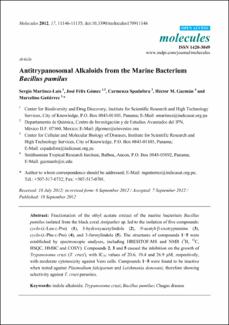| dc.contributor.author | Martínez, Luis sergio | |
| dc.contributor.author | Gómez, José Félix | |
| dc.contributor.author | Spadafora, Carmenza | |
| dc.contributor.author | Guzmán, Héctor M. | |
| dc.contributor.author | Gutiérrez, Marcelino | |
| dc.date.accessioned | 2020-06-19T05:25:20Z | |
| dc.date.available | 2020-06-19T05:25:20Z | |
| dc.date.issued | 2012-09-18 | |
| dc.identifier.issn | ISSN 1420-3049 | |
| dc.identifier.other | doi:10.3390/molecules170911146 | |
| dc.identifier.uri | http://repositorio-indicasat.org.pa/handle/123456789/98 | |
| dc.description | Fractionation of the ethyl acetate extract of the marine bacterium Bacillus pumilus isolated from the black coral Antipathes sp. led to the isolation of five compounds: cyclo-(L-Leu-L-Pro) (1), 3-hydroxyacetylindole (2), N-acetyl--oxotryptamine (3), cyclo-(L-Phe-L-Pro) (4), and 3-formylindole (5). The structures of compounds 1−5 were established by spectroscopic analyses, including HRESITOF-MS and NMR (1 H, 13C, HSQC, HMBC and COSY). Compounds 2, 3 and 5 caused the inhibition on the growth of Trypanosoma cruzi (T. cruzi), with IC50 values of 20.6, 19.4 and 26.9 μM, respectively, with moderate cytotoxicity against Vero cells. Compounds 1−5 were found to be inactive when tested against Plasmodium falciparum and Leishmania donovani, therefore showing selectivity against T. cruzi parasites. | en_US |
| dc.description.abstract | Fractionation of the ethyl acetate extract of the marine bacterium Bacillus pumilus isolated from the black coral Antipathes sp. led to the isolation of five compounds: cyclo-(L-Leu-L-Pro) (1), 3-hydroxyacetylindole (2), N-acetyl--oxotryptamine (3), cyclo-(L-Phe-L-Pro) (4), and 3-formylindole (5). The structures of compounds 1−5 were established by spectroscopic analyses, including HRESITOF-MS and NMR (1 H, 13C, HSQC, HMBC and COSY). Compounds 2, 3 and 5 caused the inhibition on the growth of Trypanosoma cruzi (T. cruzi), with IC50 values of 20.6, 19.4 and 26.9 μM, respectively, with moderate cytotoxicity against Vero cells. Compounds 1−5 were found to be inactive when tested against Plasmodium falciparum and Leishmania donovani, therefore showing selectivity against T. cruzi parasites. | en_US |
| dc.format | application/pdf | |
| dc.language.iso | eng | en_US |
| dc.rights | Info:eu-repo/semantics/openAccess | |
| dc.rights | https://creativecommons.org/licenses/by/4.0/ | |
| dc.subject | indole alkaloids | en_US |
| dc.subject | Trypanosoma cruzi | en_US |
| dc.subject | Bacillus pumilus | en_US |
| dc.subject | Chagas disease | en_US |
| dc.title | Antitrypanosomal Alkaloids from the Marine Bacterium Bacillus pumilus | en_US |
| dc.type | info:eu-repo/semantics/article | en_US |
| dc.type | Info:eu-repo/semantics/publishedversion | |

